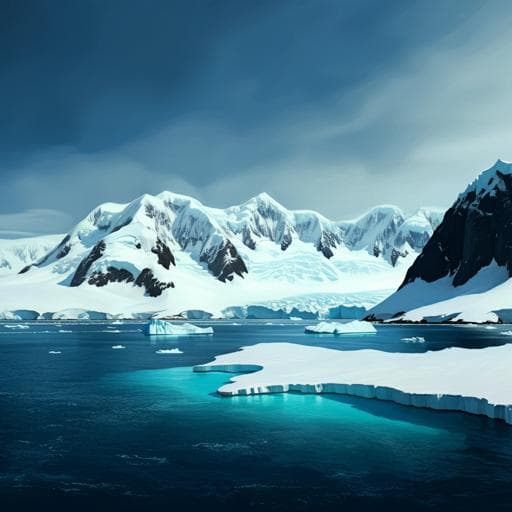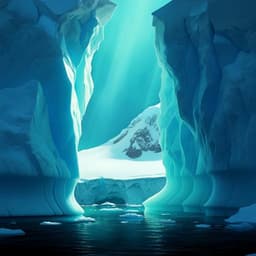
Earth Sciences
Holocene melting of the West Antarctic Ice Sheet driven by tropical Pacific warming
A. D. Sproson, Y. Yokoyama, et al.
Explore the intriguing glacial history of the Amundsen Sea sector revealed by the research conducted by Adam D. Sproson, Yusuke Yokoyama, Yosuke Miyairi, Takahiro Aze, and Rebecca L. Totten. Discover how atmospheric circulation changes linked to tropical Pacific warming drove significant ice melting and retreat 9 to 6 thousand years ago, validating contemporary ice-sheet models and informing future sea-level projections.
~3 min • Beginner • English
Introduction
Antarctic ice loss and sea-level contributions have increased since the early 21st century, particularly due to thinning, retreat, and acceleration of West Antarctic Ice Sheet outlet glaciers in the Amundsen Sea Embayment. Ice mass loss is commonly attributed to ocean-driven melting by upwelled Circumpolar Deep Water, while atmospheric processes, including enhanced precipitation, warming, and atmospheric rivers linked to tropical Pacific temperatures, also drive surface melt along the West Antarctic coast. Uncertainty remains regarding the permanence of increasing ice loss, projected sea-level contributions, and the dominant mechanisms controlling mass balance changes. Validating predictive ice-sheet models requires long-term reconstructions of past ice-sheet change since the Last Glacial Maximum. This study addresses the relative roles of oceanic versus atmospheric forcing on Holocene ice-shelf stability in the Amundsen sector using beryllium isotope records from Ferrero Bay to reconstruct Cosgrove Ice Shelf history over the last ~10.3 kyr.
Literature Review
Marine records indicate the Amundsen sector reached near-modern limits by the Early Holocene, likely driven by CDW upwelling linked to a southerly shift of the Southern Hemisphere westerlies. However, mechanisms behind subsequent early-to-mid-Holocene thinning of ice streams around the ASE remain unclear. Prior studies document: rapid Holocene thinning of Pine Island and Pope glaciers; changes in oceanographic conditions and CDW inflow; and teleconnections between tropical Pacific warming and West Antarctic atmospheric circulation, including atmospheric rivers. Existing sedimentological, micropaleontological, and geochemical proxies from Ferrero Bay and Pine Island Bay define deglacial to Holocene environmental transitions but lack a direct, continuous proxy for meltwater discharge. Beryllium isotopes (10Be and 9Be) have been developed as tracers of glacial dynamics, depositional environment, and meltwater input in polar marine and lacustrine settings, motivating their application here to refine Holocene ice-shelf and grounding-line histories in the ASE.
Methodology
Study design: Reconstruct Holocene history of the Cosgrove Ice Shelf (CIS) using beryllium isotopes measured in marine sediments from Ferrero Bay, eastern Amundsen Sea Embayment.
Coring and site details: Three Kasten cores collected during IB Oden OSO-0910 (2009–2010): KC-15 (73.36°S, 101.84°W; 1274 m water depth; 1.3 m core, innermost fjord), KC-16 (73.45°S, 102.08°W; 706 m; 0.4 m core, structural high), KC-17 (73.42°S, 102.83°W; 855 m; 1.4 m core, outer bay). Cores consist mainly of clays (clayey sand to greenish-bluish clay) and capture Holocene glacial, biological, and oceanographic changes.
Proxies measured: Reactive 10Be abundance ([10Be]reactive), reactive 9Be ([9Be]reactive), and 10Be/9Be ratios. Auxiliary published proxies include total organic carbon (TOC), total nitrogen (TN), diatom and foraminifera abundances and assemblages, and magnetic susceptibility (MS).
Be extraction and measurement: ~0.1 g sediment leached with 0.04 M hydroxylamine hydrochloride in 25% acetic acid for 7 h at 80 °C to obtain reactive phase. 9Be quantified by HR-ICP-MS (Thermo ELEMENT XR) after indium spike. Remaining leachate spiked with Be carrier, purified via acetylacetone solvent extractions with EDTA, Be(OH)2 precipitated with NH3, converted to BeO, mixed with niobium, and measured for 10Be via AMS at UTokyo MALT.
Age-depth modeling: Radiocarbon (14C) ages from two marine carbonate and seven bulk samples in KC-15 were corrected for local effects and a marine reservoir correction ΔR = 900 ± 100 yr, then calibrated using Marine13. A new age-depth model was produced using Undatable (Bayesian MatCal-based), run for 10^6 iterations with 20% bootstrapping and Gaussian SAR uncertainty factor of 0.1; depth uncertainty set to 2 cm.
Data interpretation framework: Be isotope systematics interpreted in terms of mixing between coastal (low 10Be/9Be due to fluvial 9Be) and marine sources (high 10Be and high 10Be/9Be), augmented in polar regions by meteoric 10Be inputs from atmosphere, sea ice, and ice sheets. Environmental settings (open marine vs sub-ice-shelf vs subglacial), depositional processes (dilution, scavenging/extraction efficiency), and meltwater contributions were used to infer changes in grounding-line position, ice-shelf extent, and meltwater discharge through time.
Key Findings
- The KC-15 record spans ~10.3 kyr. Three phases in 10Be/9Be: Early Holocene (~10.3–9.8 kyr BP) low ratios (~0.42–0.46), a rise from ~9.8 to ~5.9 kyr BP reaching ~2.33, and relatively constant ~2.1–2.3 through the Late Holocene.
- Lithological and proxy shifts indicate two phases of grounding-line retreat in Ferrero Bay ending by ~10.7 and ~9.6 kyr BP; subsequent establishment of a stable ice shelf from ~5.9 to ~2.3 kyr BP; transition to open marine conditions by ~2.3 kyr BP at KC-17 and ~1.4 kyr BP at KC-15.
- Strong correlations: 10Be/9Be with [10Be]reactive and TOC/TN; negative correlation with MS, reflecting transition from coarse, sand-rich basal sediments to fine-grained silt/clay upward.
- Relative 10Be vs 9Be relationships indicate additional meltwater-derived 10Be input during ~9.8–5.9 kyr BP, consistent with increased subglacial/basal meltwater discharge rather than enhanced advection from offshore.
- Presence of benthic foraminifer Bulimina aculeata at 51–71 cmbsf in KC-15 indicates some mid-Holocene CDW incursion, but Be ratios remained high and stable, suggesting limited CDW control on Be isotope variations during peak retreat.
- Regional coherence: CIS melting/retreat (9–6 cal kyr BP) coincides with thinning of Pine Island Glacier (~150 m, 8–6 cal kyr BP) and Pope Glacier (~560 m, 9–6 cal kyr BP), indicating a sector-wide melting event.
- Forcing mechanism: After ~9 kyr BP, reduced CDW influence in Pine Island Bay and progressively warming tropical Pacific conditions generated a Rossby wave train, a southerly shifted/intensified westerly jet, strengthened Amundsen Sea Low, increased atmospheric rivers and precipitation over continental West Antarctica. This led to enhanced surface melt, meltwater generation, and dynamic ice-shelf/glacier response driving CIS retreat.
- Contemporary relevance: ASE glaciers contributed 0.23 ± 0.02 mm/yr to sea-level rise (1992–2013). Findings highlight the significant role of atmospheric forcing, particularly tropical Pacific teleconnections and atmospheric rivers, in driving ice-shelf melt and retreat, informing validation of ice-sheet models and sea-level projections.
Discussion
The study set out to disentangle the relative roles of oceanic (CDW upwelling) versus atmospheric forcing on Holocene CIS stability. Be isotope records, integrated with sedimentology and microfossils, show that the major early-to-mid-Holocene retreat (9.8–5.9 kyr BP) corresponds to increased meltwater-derived 10Be and distal glacimarine deposition, implicating enhanced surface and basal meltwater production linked to atmospheric warming rather than dominant CDW forcing. Regional paleoceanographic data indicate reduced CDW inflow after ~9 kyr BP, while tropical Pacific warming intensified the Walker circulation and generated Rossby wave trains affecting the Amundsen sector. The associated southerly-shifted westerlies, strengthened Amundsen Sea Low, increased atmospheric moisture, and higher frequency of atmospheric rivers led to enhanced precipitation, surface melt, and potential hydrofracture, fostering rapid ice-flow accelerations and grounding-line retreat. Simultaneous cooling along the Antarctic Peninsula with warming in the ASE is consistent with this teleconnection pattern. Thus, the findings support a primary atmospheric driver of Holocene WAIS sector retreat, offering a process-based analog for current and future changes and providing a benchmark for validating ice-sheet and climate models.
Conclusion
This work reconstructs a 10.3 kyr history of the Cosgrove Ice Shelf using beryllium isotopes from Ferrero Bay sediments, revealing: proximal grounding line and extended ice shelf in the Early Holocene; accelerated retreat and elevated meltwater discharge between ~9.8 and ~5.9 kyr BP; mid-Holocene stability until ~2.3 kyr BP; and late Holocene transition to open marine conditions. The melting and retreat coincided with sector-wide glacier thinning and were driven mainly by atmospheric circulation changes linked to tropical Pacific warming, rather than persistent CDW forcing. These results demonstrate that Be isotopes are powerful proxies for reconstructing meltwater input and depositional environments, offering critical validation targets for ice-sheet models and improving projections of sea-level rise. Future research should better quantify Be concentrations in sea ice, ice sheets, and shelf waters, and elucidate Be incorporation pathways from grounding line to continental slope, to reduce uncertainties and enhance the proxy’s interpretive power.
Limitations
- Multiple sources and processes influence Be isotope systematics (dilution, scavenging, extraction efficiency, variable atmospheric/sea-ice/ice-sheet inputs), introducing uncertainty in deconvolving drivers of 10Be/9Be variations.
- Temporal resolution mismatches among proxies (e.g., diatom counts not aligned with Be sampling) limit direct productivity–Be comparisons.
- Limited constraints on Be abundance in sea ice, glacial ice, and shelf waters, and on how Be is incorporated into sediments across glacial environments, hinder precise source apportionment.
- While CDW incursions are inferred from foraminiferal evidence, quantifying their exact thermal impact locally remains challenging.
Related Publications
Explore these studies to deepen your understanding of the subject.







